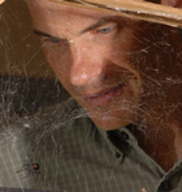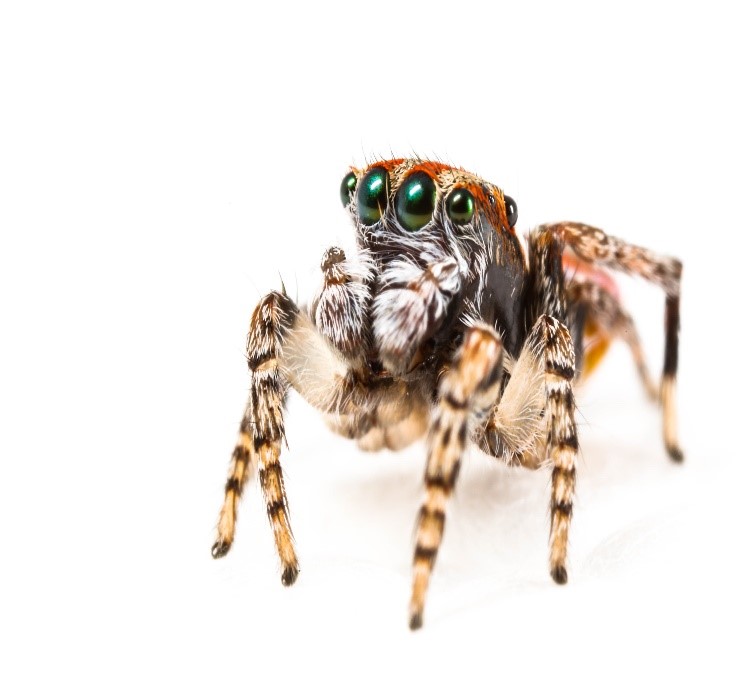-------FACULTY BELOW IN ALPHABETICAL ORDER--------
-Faculty Research Spotlight: Dr. Henry Astley
We asked Dr. Astley questions about his research. Check out his responses below!

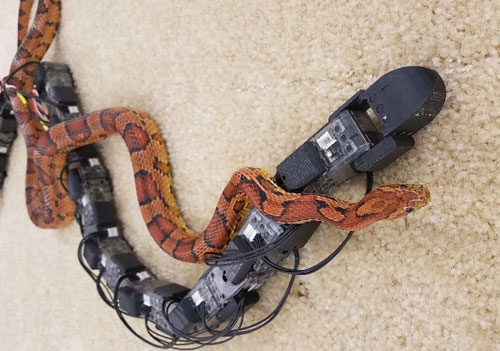
What does your research focus on?
My research focuses on the biomechanics of animal locomotion, at the intersection between biology and physics. In order to move through their environment, animals must use physiological processes to generate force, transmit this force via the musculoskeletal system and morphology, and control it via the nervous system, all while navigating through sometimes mechanically complex and heterogeneous environments.
What kinds of technical expertise do students who work in your lab gain?
Students in the Astley lab gain expertise in a variety of techniques for analysis of animal locomotion, such as force sensors, high-speed video, and in vitro muscle testing, as well as experience in robotics and 3D printing.
What is the best part of working at the University of Akron?
The Biomimicry Research & Innovation Center has brought together an amazing group of people and fostered a wonderful environment for interdisciplinary research like mine.
-Faculty Research Spotlight: Dr. Brian Bagatto

The focus of my lab is study of physiological processes during development in vertebrates. Even though a lot of developmental processes are very similar between species of vertebrates, there are many differences. Therefore, I like to use a comparative approach when designing experiments to tease out and describe these differences. Physiological variation is also a large topic in my lab.
-Faculty Research Spotlight: Dr. Hazel Barton

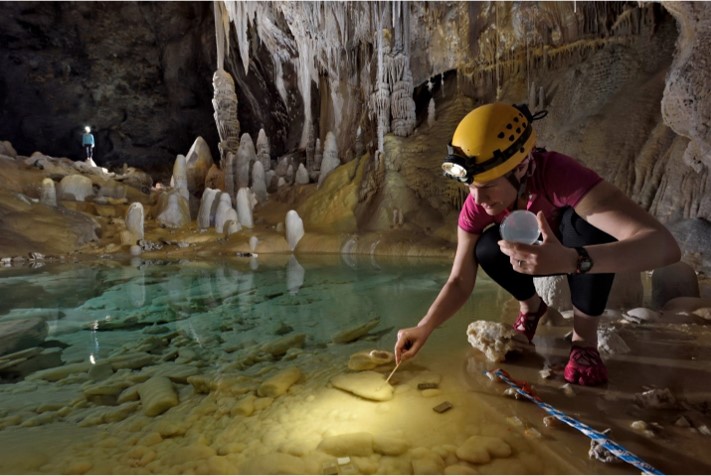
The Barton Lab studies geomicrobial interactions in caves, from understanding how rock-eating microbes can contribute to cave formation, to understanding how microbes make a living in dark, isolated caves and the evolution of antibiotics. Research in the Barton Lab is currently funded by the National Park Service, the National Science Foundation and DARPA, through collaboration across the US, in Brazil, China, Denmark and Germany, including government agencies and private companies. Students in the Barton Lab can expect to learn techniques in microbiology, molecular biology, genetic engineering, mineralogy, materials chemistry, and of course, how to carry out field research is caves.
-Faculty Research Spotlight: Dr. Todd Blackledge
We asked Dr. Blackledge questions about his research. Check out his responses below!
Dr. Blackledge's Research
Research in the Blackledge lab focuses on the interplay between biomaterial properties and behavior in the evolution of organismal performance. I investigate how changes in silk and web architecture helped make spiders dominate predators of insects in most terrestrial ecosystems. My research integrates across the biological hierarchy, from exploring the evolution of novel silk genes and protein structure to whole web performance and higher level systematics of spiders. A single spider spins a diverse toolkit of silks, including the toughest fibers in nature and environmentally responsive “smart adhesives” so my research also provides novel design principles for next-generation synthetic polymers.
What kinds of technical expertise do students who work in your lab gain?
Graduate and undergraduate students in my lab are trained in a highly interdisciplinary environment where biologists work alongside material scientists and engineers. Students gain expertise in 1) how to measure and quantify animal behavior in the laboratory and field, 2) measuring performance of biological materials using nano-tensile testing, and even 3) characterizing material structure using techniques like IR, NMR or raman spectroscopy. Students routinely engage in research outside of traditional disciplinary boundaries, preparing them for the 21st century research environment.
What is the best part of working at the University of Akron?
The biology department has a truly amazing group of faculty who support and interact with one another in ways that aren’t common at many other universities. This creates a fantastic environment for training students and promotes really dynamic research. Our Integrated Bioscience PhD program and the Biomimicry Research and Innovation Center are on the forefront of “research without boundaries”!
-Faculty Research Spotlight: Dr. Joel Duff

My students and I are involved in several projects using molecular genetic tools to investigate organismal and genetic biodiversity. From taxonomic and phylogenetic approaches to studying species and populations to whole community genetic diversity to working on signaling pathways in whales our projects involve an integrative approach to research.
-Faculty Research Spotlight: Dr. Angela Hartsock
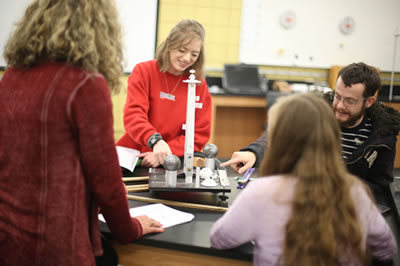
I joined Wayne College in Fall of 2013 as an Assistant Professor of Biology. Prior to that, I was a research fellow at the Department of Energy National Energy Technology Laboratory in Pittsburgh, PA from 2009-2013. My fellowship research focused on the bacterial ecology of energy systems with a focus on waters associated with natural gas drilling. From 2004-2009, I completed my doctoral training at Cornell University in the laboratory of Dr. James Shapleigh studying the genetics of denitrifying physiology in bacteria.
-Faculty Research Spotlight: Dr. Kevin Kaut

Dr. Kaut’s research deals with the neurobiology of learning and memory in animal models, head trauma (including human applications), factors influencing post-injury recovery of functions, and age effects on cognitive/behavioral responses to injury.
-Faculty Research Spotlight: Dr. Richard Londraville
We asked Dr. Richard Londraville questions about his research. Check out his responses below!
.jpg?language_id=1)
Dr. Londraville’s Lab Research
Dr. Londraville and his students are pursuing questions about how fat metabolism has evolved in the vertebrates. Most of the work deals with the hormone leptin. With > 50,000 studies done on this hormone, the lab hopes to understand more about its function in humans by comparing its function in to other vertebrate relatives. His lab, in collaboration with other labs at University of Akron and outside (including the Bagatto, Duff, Liu, Niewiarowski, Prokop and Thewissen labs) have investigated leptin function in lizards, birds, whales, and fish. Most of the current questions are focused on leptin function in zebrafish, using modern molecular techniques.
What kinds of technical expertise do students who work in your lab gain?
In order to understand the function of this hormone, we using modern molecular techniques to study cell signaling. This includes methods designed to reduce or remove expression of the protein (including morpholino injection and CRISPR), methods to measure expression of mRNA and protein (qPCR, western blot, enzyme assays, ELISA, proteomics, microarray, RNASeq), methods to analyze very large datasets (bioinformatics), and methods to visualize protein structure (computer simulation modeling). Graduate students are adding to our toolbox of techniques by pursuing new methods of inquiry (recently techniques to study transcription factors, behavior, and bone metabolism). Undergraduates usually start with something we know how to do pretty reliably, but are welcome to explore.
What is the best part of working at the University of Akron?
By far-it is the faculty and students. I work with some of the smartest, ambitious, most innovative people I have ever met (and I have met some smart people in my career). I really enjoy learning new stuff from my colleagues and students-I would stack our faculty and students up against any Ivy league school any day! I also enjoy teaching at all levels, and mentoring students. With Dr. Niewiarowski, we have offered several classes on doing research in the Tropics (in the Bahamas, Florida, and Tahiti). It is very gratifying to be able to take students from Akron and to show them these environments-life changing for all involved.
Faculty Research Spotlight: Dr. Randall Mitchell
We asked Dr. Mitchell questions about his research. Check out his responses below!
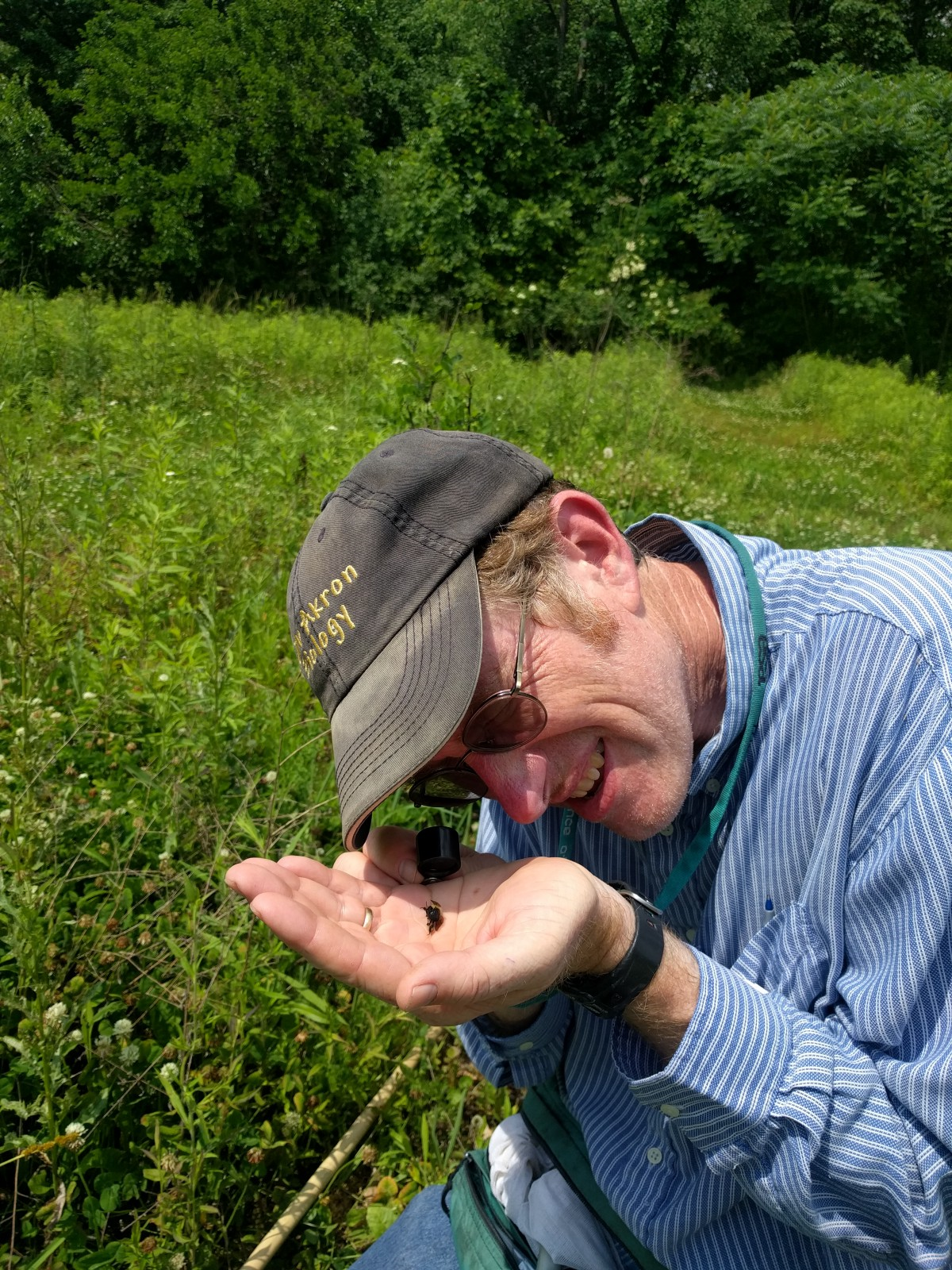

Dr. Mitchell's Research
Research in the Mitchell lab falls into two main themes - pollination, and wetlands. First, Dr. Mitchell’s main research interest is in the evolutionary ecology of plant pollinator interactions, focusing on how plant mating patterns and success are affected by pollinator behavior and abundance. Students participate in this research through extensive field work (recording pollinator behavior, measuring flowers, evaluating seed production, etc.). Much of this work focuses on mating patterns in square-stem monkeyflower (Mimulus ringens) in wetlands of the American Midwest. Careful evaluation of pollinator behavior, pollen carryover, and mating system allows understanding of the factors determining which plants are successful at mothering and fathering offspring, and how plants may compete with one another for pollinator services. These studies help answer fundamental questions about plant reproduction and about evolutionary ecology, and have important implications for conservation efforts and management of endangered or invasive species.
Second, the Mitchell lab is investigating the wetland ecology and restoration. Much of this work is centered on the UA Field station's Panzner Wetland Wildlife reserve, a 104 acre restored wetland given to The University of Akron by the Panzner Brothers. The Mitchell lab is also deeply involved in monitoring and guiding the restoration of the Tamarack bog at the Bath Nature preserve. Students are deeply involved in both projects, participating in wetland evaluation, vegetation identification and monitoring, and experimental investigations of different restoration techniques.
What is the best part of working at the University of Akron?
The best part about working at the University of Akron is taking students to the UA field station to learn more about the wonderful natural habitats of Ohio. I work with great students and great professors who share my love of the intricate beauty of living creatures and the staggering complexity of their interactions.
-Faculty Research Spotlight: Dr. Qin Liu
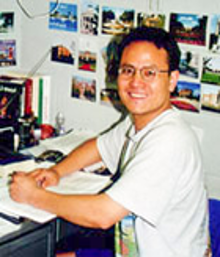
My primary research interest is to understand cell adhesion molecule cadherins function in the development of the vertebrate visual system. I have chosen to study zebrafish, which has become one of the most important animal models for studies of vertebrate development.
-Faculty Research Spotlight: Dr. Peter Niewiarowski
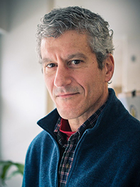
My current research includes several broad areas in ecology and evolution. I have active projects in population biology (spotted salamanders), physiological ecology and life history variation (fence lizards), and evolutionary biology/bio-inspired design (geckos). The thread which has always tied these seemingly disparate activities together is a firm foundation in evolutionary theory and analysis.
-Faculty Research Spotlight: Dr. Amir Nourhani

His research interests include microscale fluid flow, Stochastic dynamics, Trajectory classification, Electrokinetics, Acoustofluidics, External actuation, Bio-fluid dynamics.
Dr. Nourhani joined UA in 2019 as a faculty member in both Mechanical Engineering and Biology. He received an Honorable Mention for the Peter Clay Eklund Graduate Lectureship Award from The Pennsylvania State University as well as the David H. Rank Memorial Physics Award.
-Faculty Research Spotlight: Dr. Rachel Olson
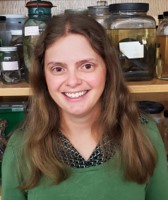
Dr. Rachel Olson's research program centers around Biomechanics of feeding, soft-tissue biomechanics, muscular hydrostats, and anatomy. More specifically,
1) exploring the biomechanics of musculoskeletal systems, 2) interpreting form and function within an evolutionary framework, and 3) addressing biomedical problems using bioinspired approaches. To accomplish this, she applies a broad range of in vivo, comparative, and computational methods, using a diversity of animal models.
-Faculty Research Spotlight: Dr. Rolando "JJ" Ramirez

My areas of interest includes cardiovascular diseases that occur during pregnancy, in particular, preeclampsia. Preeclampsia is a severe hypertensive disease that only develops during pregnancy and is the leading cause of maternal and fetal morbidity and mortality. I have been investigating this disease by studying different animal models in which we alter different facets of physiology to yield a similar phenotype to the disease…
-Faculty Research Spotlight: Dr. Jordan Renna

My research explores the mechanism of neural circuit development. In the spinal cord and cortex, neural circuits require activity-dependent mechanisms for normal maturation. This is also true in the early visual system. Waves of excitation sweep across the inner retina early in development and drive the formation of normal lamination and topography in visual centers of the brain. Disruption of these retinal waves results in miswired circuits and off-target brain projections…
-Faculty Research Spotlight: Dr. John Senko

I study how microorganisms influence the prevailing chemical conditions of a variety of “natural” and man-made systems. I am particularly interested in how the ecology, physiology, and in-situ activity of these microorganisms influence the fate of environmental contaminants. I am also interested in how microbial communities respond (in terms of community structure and activity) to physicochemical changes in their environment.
-Faculty Research Spotlight: Dr. Alan "AJ" Snow

- Snow, A.J., “Lecture Capture: Student Performance and Perceptions.” OATYC Journal. in review.
- Snow, A.J., Puri, P., Acker-Lamer, A., Bouwmeester, T., Vijayaraghavan, S., and Kline, D. “Phosphorylation-dependent interaction of tyrosine 3-monooxygenase/tryptophan 5-monooxygenase activation protein (YWHA) with PADI6 following oocyte maturation in mice.” Biology of Reproduction. 79, 337-347 (2008)
- Snow, A.J., Vijayaraghavan, S., and Kline, D. “ Phosphorylation of the Oocyte-Embryo Specific Protein PADI6 following Oocyte Maturation.” Mol. Biol. Cell 17, 486. (2006)
-Faculty Research Spotlight: Dr. Steve Weeks

I have long been interested in the evolution mating systems, working with both branchiopod crustaceans & livebearing fish. Currently, focusing on delineating the factors favoring the evolution of hermaphroditism from dioecy (separate males & females) in animals. Over the years of studying this question, my research has evolved into an interdisciplinary (or "integrative") set of projects that combine to approach the complex question of how mating systems have evolved in crustaceans. Several graduate students & I are studying a variety of ecological and genetic aspects of the unique mating system found in one genus of Crustacea (Eulimnadia), seeking to discern the costs & benefits of selfing vs. outcrossing in this interesting set of species.

